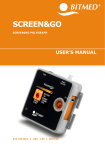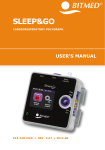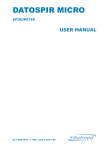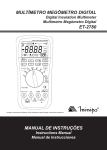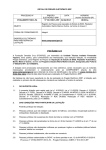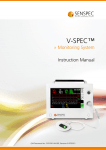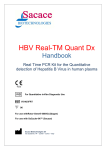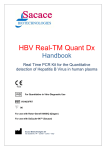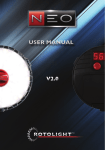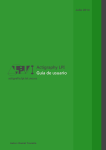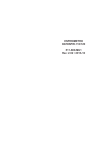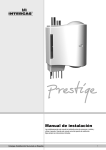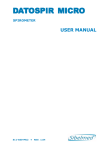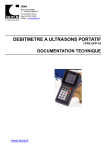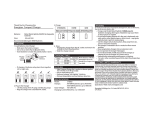Download SCREEN&GO - SibelGroup
Transcript
SCREEN&GO SCREENING polygraph USER’S MANUAL 534-70S-MU2 • REV. 1.07 • 2014-06 Screen&GO Manual Revisión: 534-70S-MU2 Rev. 1.07 All rights reserved. Please refer to the device’s Service Manual for additional information. This manual can be purchased through the After Sales Service. SIBEL S.A. Rosselló 500, 08026 Barcelona - Spain National Sales: Tel. 93 436 00 08 e-mail: comercial@sibelmed.com International Sales: Tel. +34 93 436 00 07 E-mail: export@sibelmed.com Technical service: Tel. +34 93 433 54 50 E-mail: sat@sibelmed.com Fax: +34 93 436 16 11, Website: www.sibelmed.com SIBEL, S.A. belongs to SIBELGROUP COPYRIGHT No part of this publication may be reproduced, transmitted, transcribed, stored in a back-up system or translated into any language or computer language in any form or by any means, electronic, mechanical, optical, chemical or manual without the express written consent from SIBEL S.A. DISCLAIMER SIBEL S.A. is responsible for the security, reliability and performance of this equipment only if: • The place where the systrem is installed or used meets the requirements for electrical installations IEC and other applicable regulations. • All repairs, revisions or modifications, both in and out of the warranty period, are made by technical staff of Meditel Ingeniería Médica S.L. o SIBEL S.A. • The system is used by qualified staff in accordance with the recommendations stated in this User’s Manual. BRANDS Bitmed is a registered trademark of Sibel, S.A. 534-70S-MU2 • REV. 1.07 PRODUCT IN COMPLIANCE WITH MEDICAL DEVICE DIRECTIVE 93/42/EEC (CLASS IIa). 0197 Thank you for choosing this product. SCREEN&GO system is designed and manufactured with the best guarantees of quality. Applications SCREEN&GO and its related software will open a world of possibilities in the sleep study. If you have any possible improvement for this product, we welcome your suggestions may be directed to Customer Service Department. Revised Date: 2014-06 Technical Director Approved Date: 2014-06 Sales Director 534-70S-MU2 • REV. 1.07 Screen&Go 4 Index User’s Manual TABLE OF CONTENTS SAFETY............................................................................... 6 INTENDED USE................................................................... 6 INDICATIONS FOR USE...................................................... 7 LIMITATIONS IN USE. CONTRAINDICATION...................... 7 WARNINGS AND PRECAUTIONS......................................... 8 DISPOSAL OF ELECTRICAL AND ELECTRONIC DEVICES BY DOMESTIC USERS IN THE EUROPEAN UNION................... 11 1. INSTRUCTIONS OF INSTALLATION AND USE................ 13 1.1. options .................................................................. 13 1.2 packing list............................................................ 14 1.3 LAYOUT OF CONTROLS, INDICATORS AND CONNECTORS................................................................... 18 1.3.1 FRONT/TOP/RIGHT PANNEL................................... 18 1.3.2 left PANNEL........................................................... 18 1.3.3 rear PANNEL.......................................................... 19 1.4 INSTALLATION AND start-UP................................... 19 1.4.1 BATTERy PLACEMENT.............................................. 19 1.4.2 POWER SAVING MODE............................................. 20 1.4.3 PLACEMENT OF SENSORS........................................ 20 1.4.3.1 PLACEMENT OF THE SCREEN&Go POLYGRAPH...... 20 1.4.3.2 NASAL CANNULA.................................................. 21 1.4.3.3 thermocouple AIRFLOW SENSOR...................... 22 1.4.3.4 respiratory effort band................................ 23 1.4.3.5 PULSE OXIMETER................................................. 24 1.4.3.6 body position and activity........................... 26 1.4.3.7 EVENT MARKER.................................................... 27 2. OPERATION.................................................................. 28 2.1 WORKING MODES ...................................................... 28 2.2 system configuration.......................................... 29 2.3 INITIAL DEVICE SETUP.............................................. 30 534-70S-MU2 • REV. 1.07 Screen&Go 5 User’s Manual 534-70S-MU2 • REV. 1.07 Index 2.3.1 sETTING THE DATE AND TIME................................. 30 2.3.2 SETTING THE LANGUAGE......................................... 30 2.3.3 setTING the type of batteries........................... 31 2.4 making polygraphy tests..................................... 31 2.4.1 STARTING AND ENDING A TEST MANUALLY............ 31 2.4.2 scheduleD TESTS.................................................. 32 2.4.2.1 SCHEDULING A TEST IN THE Screen&Go............ 32 2.4.2.2 DISPLAYING THE SCHEDULED TESTS.................... 34 2.4.2.3 CHANNEL configurations................................ 35 2.5 TRANSFER AND REVIEW OF THE TESTS...................... 36 2.6 FIRMWARE UPDATE.................................................... 36 2.7 DEVICE OPTIONS UPDATE.......................................... 37 3. TECHNICAL SPECIFICATIONS ...................................... 38 3.1 general data........................................................... 38 3.2 PULSE OXIMETER TECHNICAL SPECIFICATIONS......... 41 3.3 CONDITIONS of OPERATION and storage of accessories................................................................... 42 3.4 APPLICABLE STANDARDS........................................... 42 4. SYMBOLOGY................................................................. 45 4.1 SYMBOLOGY OF THE SCREEN&GO............................... 45 4.2 SYMBOLOGY OF THE ACCESSORIES............................ 46 4.3 VALIDated ACCESSORIES.......................................... 48 5 CLEANING AND MAINTENANCE . ................................... 49 5.1 cleaning.................................................................. 49 5.2 PREVENTIVE MAINTENANCE....................................... 49 5.2.1 actions to be taken by the user....................... 49 5.2.2 ACTIONS TO BE TAKEN BY QUALIFIED PERSONNEL.50 5.3 CORRECTIVE MAINTENANCE....................................... 50 ANNEX 1. ELECTROMAGNETIC COMPATIBILITY ............. 52 ANNEX 2. TROUBLESHOOTING GUIDE.............................. 56 Screen&Go 6 Declaration of conformity User’s Manual SAFETY The Screen&Go respiratory polygraph has been developed by the R+D+i Department of SIBEL S.A. with the collaboration of reference Health Centers and doctors specialized in the area of Sleep Disorders. The Screen&Go respiratory polygraph is designed and manufactured in accordance with the Quality Manual of SIBEL S.A. which is in consistency with the quality standards EN 13485 and ISO 9001 and European Directive 93/42/EEC concerning medical devices and 2007/47/EC. According to this directive the equipment is Class IIa. The Screen&Go also complies with the EN 60601.1 Electrical Safety and Electromagnetic Compatibility EN 60601.1.2 standards, as specified in the ELECTROMAGNETIC COMPATIBILITY annex. The Screen&Go also complies with the following directives and regulations: Packaging and packaging waste directive 94/62/ EC; Waste Electrical and Electronic Equipment Directive (WEEE) 2002/96/EC; Regulation EC 1272/2008 on classification, labelling and packaging of substances and mixtures (REACH). intended USE Acquisition, storage and display of biomedical signals for the simplified diagnosis and control of sleep-related breathing disorders (mainly Sleep Apnea and Hypopnea Syndrome) being anyone or any combination of the following signals: respiratory airflow, snore, thoracic effort, SpO2, beats per minute, body position, and body activity. Next conditions must be taken into account: • Use in a health center, patient’s home or similar indoor use (not for outdoor use). • Not intended for use in moving transport vehicles. • Not intended for monitoring vital signals. 534-70S-MU2 • REV. 1.07 Screen&Go 7 User’s Manual Safety INDICATIONS FOR USE The Screen&Go has been designed for maximum safety. All of the operating instructions should been read before proceeding to operate with the system. Failure to do so may result in injuries to the user or the patient and damage to the device and/or accessories. The Screen&Go has been designed for being used by a doctor or a technician trained in the acquisition of respiratory signals and the transmission of these signals to a PC during polygraphic tests. The user is allowed to configure the device under these conditions. However, it is not recommended that the configuration of the device is changed without understanding the principles of signal digitalizing. Minimum age of patients is 5 years, weighing over 15 kg and a minimum height of 70 cm. The medical staff will instruct the patient for a correct test execution, to avoid interferences in the measurement and to replace the sensors in case of movement. It is therefore important that the patient can understand the instructions given by medical staff. The intended environments of use are hospitals, sleep centres and sleep clinics. Tests may also be carried out at the patient’s home. In this case the patient is only authorized to start and stop the test, and should be adequately instructed by the doctor on this respect. The Screen&Go is not designed to be used outdoors, nor in other conditions or with energy sources not covered in this manual. Using the Screen&Go systems does not involve any monitoring or diagnosis of the patient. LIMITATIONS IN USE. CONTRAINDICATION. The interpretation of the tests and any ensuing treatment must be carried out by a doctor. The acceptability of a test is the responsibility of the health personnel. The symptoms presented by the patient before starting any test should be considered by the health personnel. The Screen&Go should not be used when it is likely that the validity 534-70S-MU2 • REV. 1.07 Screen&Go 8 Safety User’s Manual of the results may be compromised due to external factors (Electro Magnetic interference – see section EMC). WARNINGS AND PRECAUTIONS The Screen&Go IS NOT CERTIFIED FOR USE IN CONTINUOUS MONITORING, where a failure in operation may cause injuries or the death of the patient. This product does not maintain nor does it help to maintain the life of the patient. The term CONTINUOUS MONITORING is specified in regulation EN60601-1. The Screen&Go is classified as Class IIa in accordance with Directive 93/42/EEC on medical devices. The pulse oximeter is not provided with physiological-type alarms. The pulse oximeter is calibrated to display functional oxygen saturation and requires no calibration. The pulse oximeter waveform is not standarized. The Sleep&Go is not intended for monitoring vital signals. There are no applicable parts to the patient which produce stimulation. The system has no user-serviceable parts. Use only authorized service and spare parts supplied by the manufacturer. Contact of liquids with the internal parts of the device and the connectors must always be avoided. The system is only resistant to moderate splashing and dripping (Protection level IP22: protection against access to hazardous parts with a finger; protected against solid objects with a diameter of 12.5 mm and above; protected against water drops falling vertically with a maximum inclination of 15 degrees of the envelope). Do not submerge the parts of the device in any liquid. MAY CAUSE ELECTRIC DISCHARGE. No parts are allowed for temporary immersion. The cleaning instructions in this manual and also in the instructions 534-70S-MU2 • REV. 1.07 Screen&Go 9 User’s Manual Keep your device protected from shock and vibration. During transportation, place all the items in the carrying case. The material provides enough protection against small accidental impact. Do not use the system in and MRI environment. The system is not designed to work in an explosive environment or in the presence of flammable anesthetics or gases of any kind. MAY CAUSE EXPLOSION. This product is intended for indoor use (e.g. at the patient’s home or hospital) and is not suitable for use during patient transportation. The polygraph is not intended to be used outdoors or with other conditions or energy sources that are not covered in this manual. The Screen&Go is not protected against defibrillation shocks. Therefore, never use a defibrillator on a patient connected to a Screen&Go system. Do not use an electric scalpel or a high frequency surgical device while the patient is connected to any sensors of the Screen&Go. The use of mobile phones, transmitters and similar equipment generating radio frequency emissions and placed next to the system is not allowed during the tests. Therefore, do not use the system in the presence of radio equipment (mobile phones, walkietalkie ...). Follow the recommendations regarding the separation distance specified in the manufacturer’s declaration for EMC in this manual. Remember that when multiple devices are connected to a patient there is a risk of accumulation of leakage current. Minimize the number of devices. Do not remove the device cover. The service and repair of the device should be carried out only by trained personnel. The Screen&Go system is prepared to work at room temperature. Avoid exposing any part of the system to heat sources. Also avoid direct exposure to sunlight. Temperature changes cause 534-70S-MU2 • REV. 1.07 Safety of use of any sensor supplied but not manufactured by SIBEL S.A. must be carefully followed. Screen&Go 10 Safety User’s Manual condensation and moisture. Before using the system, allow the device to acclimate to ambient temperature. For reference, if the temperature difference between the system and the environment is above 10º C a 20 minutes wait time in an intermediate temperature is recommended. The polygraph should not be placed adjacent to or stacked with other equipment. The system shall be stored and used within the temperature ranges, pressure and humidity specified in section number 3. Artifacts in the signal may be produced as a result of ESD. A trained operator should be able to recognize these artifacts easily. The operator must be trained to be able to recognize the differences between a biological signal and signal artifacts caused by patient movements, RF interference or poor placement of the sensors. The presence of ESD or RF devices will not lead to wrong conclusions. Unusable data is not considered a risk to the patient safety. Cables or sensors should not surround the patient’s neck, especially when the patient is a child. The Screen&Go system does not increase the safety risk for patients with pacemakers in accordance with the EN50061 standard (Medical electrical equipment – Safety of implantable cardiac pacemakers). Before using the system in patients with pacemakers, the operator should check the documents accompanying the pacemaker with respect to its certification and requirements of use and, if necessary, contact the manufacturer. Patients must be insistently warned that they must not open the Screen&Go or attempt to adjust it. Sensors or accessories in bad condition should not be used. Use only the Screen&Go with accessories and sensors provided by the manufacturer or dealer, or those that meet the specifications of this manual. The use of other sensors with the Screen&Go can cause damage to the device or the quality of the signals. Sensors should be handled by their strongest parts, which are the connectors. Also, they should not get wet or exposed to very 534-70S-MU2 • REV. 1.07 Screen&Go 11 User’s Manual The polygraph is designed to be used exclusively by medical staff, who should be supervised and instructed by a physician. Medical personnel should inform the patient about precautions to be found in the WARNINGS AND PRECAUTIONS section and to be taken when using the equipment. Use the provided carrying case when transporting the device and its accessories. Do not reuse single-use accessories as there is risk of infection to the patient. In case of doubt or unexpected event contact the manufacturer. You can find contact details on page 2 of this manual. The use of nasal cannulas is not recommended in pregnant women or children, because they contain phtalates. Do not leave the batteries inside the device if it won’t be used for a long period of time. Ensure to perform the adquisition of signals in an acustic and light environment that allows the patient to sleeping normally. DISPOSAL OF ELECTRICAL AND ELECTRONIC DEVICES BY DOMESTIC USERS IN THE EUROPEAN UNION Never dispose of the Screen&Go, its accessories and its batteries in the household trash. It must be disposed of properly and may need to be recycled in accordance with the statutory requirements in your country. • Materials according to the RoHS Directive 2011/65/UE. Conform from July 22th, 2014. The device uses a lithium battery and could use an optional NiMh battery. 534-70S-MU2 • REV. 1.07 Safety abrupt changes of temperature. To clean the sensors, do not use abrasive chemicals. Do not apply excessive stress to the sensors. In particular, avoid bending any part of the sensors. This means that the material should not bend more than necessary in normal use. Screen&Go 12 User’s Manual - Respiratory polygraph - Screen&Go User’s Manual For devices commercialised before July 22th, 2014: Sleepsense sensors may contain PBB and PBDE. • Materials according to the Medical Device Directive: two of the sensors that may be used in combination with the device, contains phtalates (Sleepsense nasal cannula and Pro-Tech nasal cannula). The device and all the accesories are latex free. • Materials according to the REACH regulation: neither the device nor its accessories use any hazardous substance according to REACH regulation. • In the event that the device or its accessories are infected at the time of recycling, it must be disinfected or disposed by following the national regulations regarding the disposal of infected products. Information on proper disposal is available from your dealer or from Technical Support at SIBEL S.A. 534-70S-MU2 • REV. 1.07 Screen&Go 13 User’s Manual 1.1. options The Screen&Go screening polygraph is available with the the following features: Channels Screen&Go Airflow Snore Nasal cannula Auxiliary SpO2 BPM External Xpod Body position Activity Marks Default Option 534-70S-MU2 • REV. 1.07 User’s Manual - Respiratory polygraph - Screen&Go 1. INSTRUCTIONS OF INSTALLATION AND USE Screen&Go 14 User’s Manual - Respiratory polygraph - Screen&Go User’s Manual 1.2 PACKING LIST RELACIÓN DE CONTENIDO / PACKING LIST 534-708-120 REV. 4 SCREEN&GO/SLEEP&GO 2014-06 MODELOS/ MODELS CÓDIGO CODE CANT. QTY. DESCRIPCIÓN DESCRIPTION SCREEN&GO SLEEP&GO A B POLÍGRAFO / POLYGRAPH _______ 1 SCREEN&GO/SLEEP&GO SN: 347 - _______ 06312 1 BANDA DE SUJECIÓN TAMAÑO GRANDE (L) / FASTENING BELT LARGE SIZE (L) 08049 1 08087 1 Accesorios Estándar / Standard Accessories 06309 1 08088 1 06314 1 01420 1 07678 1 08089 1 06308 1 01420 (*) 1 (*) 07678 1 08090 1 06310 1 08091 1 06346 1 08060 1 (*) CÁNULA DESECHABLE NASAL / DISPOSABLE NASSAL CANNULA MÓDULO TERMOPAR (INCLUYE ACTIVACIÓN DEL CANAL) / THERMOCOUPLE MODULE (INCLUDES CHANNEL ACTIVATION) • SENSOR TERMOPAR / THERMOCOUPLE SENSOR MÓDULO DE ESFUERZO TORÁCICO INDUCTIVO (INCLUYE ACTIVACIÓN DEL CANAL) / INDUCTIVE THORACIC EFFORT MODULE (INCLUDES CHANNEL ACTIVATION) • INTERFAZ DE AMPLIFICACIÓN BANDA INDUCTIVA ESFUERZO TORÁCICO / THORAX EFFORT INDUCTIVE BAND AMPLIFICATION INTERFACE • BANDA INDUCTIVA ELÁSTICA TAMAÑO EXTRA GRANDE (XL) / ELASTIC INDUCTIVE BAND XTRA LARGE SIZE (XL) • ANILLA SUJECIÓN / FASTENING RING MÓDULO DE ESFUERZO ABDOMINAL INDUCTIVO PARA SLEEP&GO (INCLUYE ACTIVACIÓN DEL CANAL) / INDUCTIVE ABDOMINAL EFFORT MODULE FOR SLEEP&GO (INCLUDES CHANNEL ACTIVATION) • INTERFAZ DE AMPLIFICACIÓN BANDA INDUCTIVA ESFUERZO ABDOMINAL / ABDOMINAL EFFORT INDUCTIVE BAND AMPLIFICATION INTERFACE • BANDA INDUCTIVA ELÁSTICA TAMAÑO EXTRA GRANDE (XL) / ELASTIC INDUCTIVE BAND XTRA LARGE SIZE (XL) • ANILLA DE SUJECIÓN / FASTENING RING CANAL AUXILIAR (MOVIMIENTO EXTREMIDADES) PARA SLEEP&GO (INCLUYE ACTIVACIÓN DEL CANAL) / AUXILIARY CHANNEL (LIMB MOVEMENT) FOR SLEEP&GO (INCLUDES CHANNEL ACTIVATION) • KIT SENSOR MOVIMIENTO EXTREMIDADES / MOVEMENT SENSOR KIT --- LIMB CANAL AUXILIAR (RONQUIDO) PARA SLEEP&GO (INCLUYE ACTIVACIÓN DEL CANAL) / AUXILIARY CHANNEL (SNORING) FOR SLEEP&GO (INCLUDES CHANNEL ACTIVATION) • --- --- SENSOR RONQUIDO PIEZOELÉCTRICO / PIEZOELECTRIC SNORE SENSOR TARJETA MEMORIA MICRO SD CON ADAPTADOR SD / MICROSD MEMORY CARD WITH SD ADAPTER CUANDO SE ENTREGA LA REFERENCIA 08089 JUNTO CON UN SCREEN/SLEEP&GO NO SE INCLUYE LA REFERENCIA 01420 (PAQUETE DE 2 BANDAS INDUCTIVAS TAMAÑO XL), PUESTO QUE YA ESTÁ INCLUIDA EN LA REFERENCIA 08088. LA REFERENCIA 01420 SE INCLUIRÁ SÓLO SI EL MÓDULO 08089 SE SUMINISTRA POR SEPARADO. WHEN THE REFERENCE 08089 IS SUPPLIED WITH A SCREEN / SLEEP & GO DOES NOT INCLUDE REFERENCE 01420 (PACK OF 2-BAND INDUCTIVE SIZE XL), SINCE IT IS ALREADY INCLUDED IN THE REFERENCE 08088. THE REFERENCE 01420 IS INCLUDED ONLY IF THE MODULE 08089 IS DELIVERED SEPARATELY. 1/4 534-70S-MU2 • REV. 1.07 Screen&Go 15 User’s Manual 534-708-120 REV. 4 SCREEN&GO/SLEEP&GO 03673 2 PILAS ALCALINAS AA 1.5V / AA 1.5V ALKALINE BATTERY 08011 1 MALETÍN TRANSPORTE SCREEN&GO CARRYING CASE SCREEN&GO 08010 1 MALETÍN TRANSPORTE SLEEP&GO / CARRYING CASE SLEEP&GO 1 CD SOFTWARE BITMEDLAB (CON LICENCIA) / CD BITMEDLAB SOFTWARE (WITH LICENSE) 08070 ______ 1 • MANUAL DE USO / USER’S MANUAL (Doc.534-740-MU_) 08072 08071 1 1 • MÓDULO BASE DE DATOS / DATABASE MODULE • MÓDULO ANALISIS AUTOMÁTICO EVENTOS / AUTOMATIC EVENTS DETECTION MODULE 2014-06 --- --- --- --- --- ______ 1 SCREEN&GO MANUAL DE USO / SCREEN&GO USER’S MANUAL (Doc. 534-70S-MU_) ______ 1 SLEEP&GO MANUAL DE USO / SLEEP&GO USER’S MANUAL (Doc. 534-7AB-MU_) ______ 1 GUÍA RÁPIDA SCREEN - SLEEP&GO / SCREEN-SLEEP&GO QUICK GUIDE (Doc. 534-7AB-GR_) 08094 1 LECTOR TARJETAS MEMORIA USB PARA PC / USB MEMORY CARD READER FOR PC 08073 1 MÓDULO BITMED VISION PARA BITMEDLAB / BITMED VISION MODULE FOR BITMEDLAB 06976 1 KIT DE PULSIOXIMETRÍA ADULTOS PARA SCREEN&GOSLEEP&GO (Canales: SPO2, BPM) / ADULT PULSE OXIMETRY KIT FOR SCREEN&GO-SLEEP&GO (Channels: SpO2, BPM) 08098 1 • 08012 1 • --- Accesorios Opcionales / Optional Accessories --- MODULO PULSIOXIMETRIA XPOD / XPOD PULSE OXIMETRY MODULE SENSOR PULSIOXIMETRIA SOFT (ADULTO) / SOFT PULSE OXIMETRY SPO2 SENSOR (ADULT) 07677 1 08069 1 08098 1 08013 07677 08078 1 OPCIÓN FIRMWARE CANAL DE RONQUIDO POR PRESIÓN / PRESSURE SNORING CHANNEL FIRMWARE OPTION 08079 1 OPCIÓN FIRMWARE CANAL DE POSICIÓN CORPORAL / BODY POSITION CHANNEL FIRMWARE OPTION 08080 1 OPCIÓN FIRMWARE CANAL DE ACTIGRAFÍA / ACTIGRAPHY CHANNEL FIRMWARE OPTION 08081 1 OPCIÓN FIRMWARE CANAL DE MARCAS DEL PACIENTE / PATIENT’S MARKS CHANNEL FIRMWARE OPTION 08082 1 OPCIÓN FIRMWARE CANAL DE PRESIÓN CPAP / CPAP PRESSURE CHANNEL FIRMWARE OPTION --- 08083 1 OPCIÓN FIRMWARE CANAL DE ONDA DE PULSO / PULSE WAVE CHANNEL FIRMWARE OPTION --- 08084 1 OPCIÓN FIRMWARE MÓDULO BLUETOOTH / BLUETOOTH MODULE FIRMWARE OPTION --- 08022 1 08251 1 MÓDULO DE SENSORES EXG / EXG SENSOR MODULE • PIEZA ANTI APERTURA TAPA BATERÍAS / BATTERY COVER BLOCKING PIECE • MUÑEQUERA DE SUJECIÓN / WRISTBAND KIT DE PULSIOXIMETRÍA PEDIÁTRICO PARA SCREEN&GO/SLEEP&GO (Canales: SPO2, BPM) / PEDIATRIC PULSE OXIMETRY KIT FOR SCREEN&GO/SLEEP&GO(Channels: SpO2, BPM) • MODULO PULSIOXIMETRIA XPOD / XPOD PULSE OXIMETRY MODULE 1 • 1 SENSOR PULSIOXIMETRIA SOFT (PEDIÁTRICO)/ SOFT PULSE OXIMETRY SPO2 SENSOR (PEDIATRIC) • MUÑEQUERA DE SUJECIÓN / WRISTBAND --2/4 534-70S-MU2 • REV. 1.07 User’s Manual - Respiratory polygraph - Screen&Go RELACIÓN DE CONTENIDO / PACKING LIST Screen&Go 16 User’s Manual - Respiratory polygraph - Screen&Go User’s Manual RELACIÓN DE CONTENIDO / PACKING LIST 534-708-120 REV. 4 SCREEN&GO/SLEEP&GO 2014-06 08085 1 08701 1 • ELECTRODO CUCHARA ORO EXG (PAQUETE 10U) / EXG GOLD CUP ELECTRODES (PACKAGE 10PC) 01644 3 • CABLE ADAPTADOR 1MM A 1.5MM / CABLE ADAPTER 1MM TO 1.5MM 02741 3 • PUENTE DE INTERCONEXIÓN / INTERCONNECTION BRIDGE 08086 1 08093 1 • CABLES PARA ELECTRODOS DE CORCHETE (PAQUETE 10U) / CABLES FOR BUTTON STUD TYPE ELECTRODES (PACKAGE 10 PC) 01027 1 • ELECTRODO DE ECG (PAQUETE 50 uni.) / ECG ELECTRODE (PACKAGE 50 units) 01644 3 • CABLE ADAPTADOR 1MM A 1.5MM / CABLE ADAPTER 1MM TO 1.5MM 06346 1 SENSOR RONQUIDO PIEZOELÉCTRICO / PIEZOELECTRIC SNORE SENSOR 07679 1 CÁNULA NASAL DESECHABLE PROTECH (PAQUETE DE 60u) / DISPOSABLE PROTECH NASAL CANNULA (PACK OF 60u) 07680 1 CÁNULA ORO-NASAL DESECHABLE PROTECH (PAQUETE DE 30u) / DISPOSABLE PROTECH ORO-NASAL CANNULA 40cm (PACK OF 30u) 07681 1 CÁNULA ORO-NASAL DESECHABLE SLEEPSENSE (PAQUETE DE 5u) / DISPOSABLE SLEEPSENSE ORONASAL CANNULA 60cm (PACK OF 5u) 08049 1 CÁNULA NASAL DESECHABLE SLEEPSENSE / DISPOSABLE SLEEPSENSE NASAL CANNULA 06311 1 BANDA DE SUJECIÓN TAMAÑO PEQUEÑO (S) / FASTENING BELT SMALL SIZE (S) 06313 1 BANDA DE SUJECIÓN TAMAÑO EXTRA GRANDE (XL) / FASTENING BELT XTRA LARGE SIZE (XL) 01425 1 BANDA INDUCTIVA ELÁSTICA TAMAÑO PEQUEÑA (S) / ELASTIC INDUCTIVE BAND SMALL SIZE (S) 01424 1 BANDA INDUCTIVA ELÁSTICA TAMAÑO MEDIANA (M) / ELASTIC INDUCTIVE BAND MEDIUM SIZE (M) 01421 1 BANDA INDUCTIVA ELÁSTICA TAMAÑO GRANDE (L) / ELASTIC INDUCTIVE BAND LARGE SIZE (L) 01420 1 BANDA INDUCTIVA ELÁSTICA TAMAÑO EXTRA GRANDE (XL) / ELASTIC INDUCTIVE BAND XTRA LARGE SIZE (XL) 01417 1 BANDA INDUCTIVA ELÁSTICA TAMAÑO EXTRA EXTRA GRANDE (XXL) / ELASTIC INDUCTIVE BAND XTRA XTRA LARGE SIZE (XXL) 08701 1 ELECTRODO CUCHARA ORO EXG (PAQUETE 10u) / GOLD CUP ELECTRODES (PACK OF 10u) 08093 1 CABLES PARA ELECTRODOS DE CORCHETE (PAQUETE DE 10u) / CABLES FOR BUTTON STUD TYPE ELECTRODES (PACK OF 10u) --- 01027 1 ELECTRODO DE ECG (PAQUETE DE 50u) / ECG ELECTRODE (PACK OF 50u) --- KIT DE ELECTRODOS EEG PARA SLEEP&GO / EEG SENSOR KIT FOR SLEEP&GO --- KIT DE ELECTRODOS ECG PARA SLEEP&GO / EKG SENSOR KIT FOR SLEEP&GO ESTÁNDAR STANDARD OPCIONAL OPTIONAL --- --- EXG --- --- NO DISPONIBLE NOT AVAILABLE 3/4 534-70S-MU2 • REV. 1.07 Screen&Go 17 User’s Manual 534-708-120 REV. 4 SCREEN&GO/SLEEP&GO 2014-06 ADVERTENCIA: • • • • LOS ARTÍCULOS Y CANTIDADES RELACIONADAS ANTERIORMENTE HAN SIDO CUIDADOSAMENTE COMPROBADAS. EN CASO DE FALTAS O DESPERFECTOS PROCEDAN A COMUNICÁRNOSLO LO MAS PRONTO POSIBLE. SI DETECTA CUALQUIER DAÑO EN EL EMBALAJE, CONTACTE CON SU DISTRIBUIDOR ANTES DE PROCEDER A LA INSTALACIÓN DEL EQUIPO. NO SE DEBE DESPRENDER DE LOS EMBALAJES, BOLSAS, ETC. HASTA QUE VERIFIQUE TOTALMENTE EL CORRECTO FUNCIONAMIENTO DEL EQUIPO. EN CASO DE DEVOLUCIÓN DE MATERIAL O EQUIPO EN DEPOSITO, ROGAMOS NOS LO ENVÍEN EN PERFECTO ESTADO, COMPLETO DE ACCESORIOS Y DEBIDAMENTE EMBALADO. CUALQUIER DESPERFECTO OCASIONADO PROVOCARÍA UN CARGO CORRESPONDIENTE EN LA REPARACIÓN O EN LA REPOSICIÓN. WARNING: • • • • THE ITEMS AND QUANTITIES RELATED BEFORE HAVE BEEN CAREFULLY CHECKED. IN CASE OF ANY PART IS MISSING OR IS DAMAGED, NOTIFY US AS QUICKLY AS YOU CAN. IF YOU DETECT ANY DAMAGE IN THE PACKAGING, CONTACT WITH YOUR DISTRIBUTOR BEFORE PROCEEDING TO INSTALL IT. DO NOT THROW AWAY THE PACKAGING, BAGS, ETC. UNTIL THE CORRECT FUNCTIONING OF THE DEVICE IS VERIFIED IN THE CASE OF RETURNING THE GOODS, IT WILL BE APPRECIATED THAT YOU SEND THE DEVICE IN PERFECT ORDER, WITH ALL THE ACCESSORIES AND PROPERLY PACKAGED. ANY DAMAGE SUFFERED WILL MAKE A CHARGE CORRESPONDING TO REPAIR OR NEW PARTS. PREPARADO/PREPARED BY: ................................. FECHA/DATE: ............. 4/4 534-70S-MU2 • REV. 1.07 User’s Manual - Respiratory polygraph - Screen&Go RELACIÓN DE CONTENIDO / PACKING LIST Screen&Go 18 User’s Manual - Respiratory polygraph - Screen&Go User’s Manual 1.3 LAYOUT OF CONTROLS, INDICATORS AND CONNECTORS 1.3.1 FRONT/TOP/RIGHT PANNELs SpO2: XPod pulse oximeter connector Nasal cannula: nasal cannula connector Color LCD Aux: auxiliary channel connector (suitable for both the thermocouple airflow sensor and the respiratory effort band) Joystick Status LED 1.3.2 LEFT PANNEL MicroSD memory card slot ON/OFF button 534-70S-MU2 • REV. 1.07 Screen&Go 19 User’s Manual User’s Manual - Respiratory polygraph - Screen&Go 1.3.3 REAR PANNEL Battery compartment (2x AA alkaline or rechargeable batteries) 1.4 INSTALLATION AND start-UP This system is made of solid-state professional components manufactured under stringent quality controls. However, accidents may occur during the transportation or storage, being convenient an initial checking of the device and accessories prior to installation. If you detect a deterioration in the package, please contact the transport company and your supplier immediately, prior to installation. Do not dispose the packaging until completely verifying the proper functioning of the system. Use only accessories described in this manual. The use of not recommended accessories could adversely affect both the patient safety and the equipment. 1.4.1 BATTERy PLACEMENT The Screen&Go system uses two 1.5V AA batteries. You can use alkaline or rechargeable batteries with, at least, 2450mA/h. Using smaller capacity batteries diminishes the autonomy. The autonomy in normal use is about 24 hours. The battery compartment is located on the rear panel, protected by a cap that needs to be removed to proceed to change the batteries. 534-70S-MU2 • REV. 1.07 Screen&Go 20 User’s Manual - Respiratory polygraph - Screen&Go User’s Manual Before opening the battery compartment to replace the batteries please switch off the Screen & Go. 1.4.2 POWER SAVING MODE To save power, the device switches off the display after 50 seconds of inactivity (even if it is running a test) and the whole device after 5 minutes if the user does not start a test nor interacts with the joystick. 1.4.3 PLACEMENT OF SENSORS 1.4.3.1 PLACEMENT OF THE SCREEN&Go POLYGRAPH The small size and weight of the Screen&Go system allows the patient to wear it comfortably fastened with a strap. Follow these steps to fasten the device to the patient: • Insert the strap between the two guides in the rear side of the Screen&Go. • Place the device on the patient’s chest, in a comfortable position midway between the thoracic effort band (which should be on top) and the abdominal effort band (which should be below). • Secure the strap by means of the Velcro so that the device stands firm. 534-70S-MU2 • REV. 1.07 Screen&Go 21 User’s Manual User’s Manual - Respiratory polygraph - Screen&Go General placement schema 1.4.3.2 NASAL CANNULA The nasal airflow cannula (refs. 07679, 07680, 07681, 08049) is used to acquire the airflow and snoring signals, by means of the device’s internal pressure transducer. The placement of the nasal cannula has a significant impact in obtaining high quality signals. Follow these steps to place it properly: • Place the cannula over the upper lip. Bend the nasal probes softly until the tips are exposed to the maximum possible air flow. The tips should not get in contact with the skin or 534-70S-MU2 • REV. 1.07 Screen&Go 22 User’s Manual - Respiratory polygraph - Screen&Go User’s Manual penetrate the nasal orifice. • Wrap the tube around the ears and place it under the chin. Surgical tape can be used to fasten the tubes to the cheeks of the patient. If necessary, adjust the tubes under the chin. • Insert the cannula connector in the Luer connector of the Screen&Go (labeled as “Nassal cannula”) and turn it until secured. 1.4.3.3 thermocouple AIRFLOW SENSOR In addition to the nasal cannula, the Screen&Go may also use the thermocouple sensor (ref. 06309) in order to measure the respiratory airflow. Both the thermocouple airflow sensor and the effort band are to be connected to the connector labeled as “Aux” and therefore both can not be used at the same time. The quality of the registered signal depends on variables such as the filters selected in the software, the sensor placement, the patient’s respiration and room temperature. Filters can reduce the noise in the respiratory signal, but they can also add distortion to the signal if used in excess. Filters are applied in the BitmedLab software. Read that software’s manual if you need to modify them. The placement of the thermocouple sensor has a significant impact in obtaining high quality signals. Follow these steps to place it properly: • Place the thermocouple on the upper lip. Bend the nasal tips softly until the ends of the sensor are exposed to the maximum possible air flow. The tips should not get in contact with the 534-70S-MU2 • REV. 1.07 Screen&Go 23 User’s Manual • Wrap the cable around the ears and place it under the chin. Surgical tape can be used to fasten the cables to the cheeks of the patient. If necessary, adjust the sensor cable on the chin. • Bend the oral probe softly in its position in front of the mouth, so that the end of the sensor is exposed to the greatest oral flow possible, approximately 1 cm from the mouth. The probe should not touch the skin or the lips, nor penetrate the oral cavity. • Insert the sensor connector in the connector of the Screen&Go labeled as “Ther”. The ambient temperature affects the magnitude of the signal. If the temperature is similar to the patient’s temperature, the signal level may be very low. On the other side, if the ambient temperature is very different from the patient’s temperature, the signal level will be higher. 1.4.3.4 respiratory effort band The inductive plethysmography belt (refs. 01425, 01424, 01421, 01420, 01417) supplied with the Screen&Go is based in the RIP technology (Respiratory Inductive Plethysmography). • Strap the sensor band around the patient’s chest or abdomen, over any clothing. • Attach the first wire of the interfaze box (ref. 06314) to the snap that is on the same side of the band as the Velcro patch. • While holding this end to the left of the patient’s center line, wrap the band around the patient’s chest or abdomen. 534-70S-MU2 • REV. 1.07 User’s Manual - Respiratory polygraph - Screen&Go skin or penetrate the nasal orifice. Screen&Go 24 User’s Manual - Respiratory polygraph - Screen&Go User’s Manual • Pull the other end over the first end and secure the band on the right side of the center line. The band should be snug but not too tight. • Attach the second wire to the exposed snap. Make the connection and disconnection of the snaps with the interface box disconnected from the computer. • Both the thermocouple airflow sensor and the effort band are to be connected to the connector labeled as “Aux” and therefore both can not be used at the same time. • Fix each of the little boxes to the corresponding belt with the aid of the provided strips. 1.4.3.5 PULSE OXIMETER The system is able to provide the pulse wave, as well as the measurement of the pulse rate and the functional oxygen saturation, based on the technology developed by Nonin Medical Inc. The external pulse-oximeter (named XPod) (ref. 08098) is to be connected on the top side of the device. The SpO2 sensor is to be connected on the free end. Pay special attention to the sensor being used. Please consult the manufacturer before using non-recommended sensors. In adults, the ideal point for the application of the oximeter sensor is the index finger. However, it may also be placed in other fingers when the thickness is between 5mm and 21mm (0.2” and 0.8”), (dimension “H” in the figure). To place pulse oximeter sensor, follow these steps: • Place the wristband provided in the patient’s wrist and insert the XPod module into the socket. • Insert a finger (preferably the index finger) in the sensor until the finger tip reaches the stop. It is not recommended to place 534-70S-MU2 • REV. 1.07 Screen&Go 25 User’s Manual • To obtain the best results, fasten the cable to the finger, using surgical tape, preferably around the base of the finger. Make sure that the tape fastening the cable does not restrict blood circulation. • Take the cable coming out of the wristband over the arm and connect it to “SpO2” of Screen&Go. Furthermore, the following conditions of use should be observed: • The oximeter must not be used by itself to reach important medical conclusions. Medical caution must always be taken and other means must be used, whenever possible, for confirmation. • Incorrect use or inappropriate handling of the sensor can cause damage to the sensor or cable. This would lead to incorrect measurements and readings. • Remove nail polish or artificial nails before applying the sensor, as they could cause incorrect readings. • The sensors cannot be sterilized. Do not submerge the sensors in liquid. The sensors must be disconnected from the Screen&Go prior to cleaning or disinfection. • The operation of the oximeter sensor may be affected by the presence of strong room lighting. If necessary, the sensor area must be protected (e.g. with surgical tape). • The oximeter may not be capable of detecting minimal values of saturation with the same degree of accuracy and precision as the maximum values of saturation. It is also possible that it can not quantify the degree of existing hyperoxemia. 534-70S-MU2 • REV. 1.07 User’s Manual - Respiratory polygraph - Screen&Go this sensor in the thumb. Keep the fingernail of the patient pointing toward the top side of the sensor. Make sure that long fingernails do not interfere with the adequate positioning of the finger. Screen&Go 26 User’s Manual - Respiratory polygraph - Screen&Go User’s Manual • Interferences such as movements, abnormal hemoglobins, intravascular contrasts, states of low perfusion and skin pigmentation may affect the operation of the pulse oximeter. • It is unlikely that organisms are transmitted via pulse oximetry. However, we recommend washing the pulse oximetry sensor for each change of patient with soapy water or disinfectant solution as specified by the manufacturer. • The pulse oximetry module and the pulse oximetry probe is CE marked. The temperature of the area of the probe in contact with the finger will not reach temperatures > 42 °. • See the instructions for use before use. Strictly follow the manufacturer’s safety instructions, as well as those specified in this manual. • The maximum recommended time of application of an pulse oximeter in the same place is 24 hours. The point of placement must be checked frequently to determine the position, circulation and cutaneous sensitivity of the patient. Reaction to the sensors by the patients may be different depending on their state of health and skin condition. Adhesive material must not be used if the patient shows an allergic reaction to such material. • For long-term measurements, it is recommended to use flexible or disposable sensors. • The adult sensor is for people over 12 years of age (>40Kg). The pediatric sensor is for children aged between 5 and 12 years of age (15-40 kg). • The system can measure the pulse rate and functional oxygen saturation. A functional meter can not be used to evaluate the accuracy of a pulse oximetry sensor or a pulse oximetry monitor. • Do not use blood flow restrictors because they can lead to loss of signal. 1.4.3.6 body position and activity The Screen&Go records information about the patient’s body 534-70S-MU2 • REV. 1.07 Screen&Go 27 User’s Manual 1.4.3.7 EVENT MARKER During the test (either online or in holter mode), the patient is allowed to make a mark by simply pressing the joystick for at least 3 seconds. After these 3 seconds the screen lights on and the mark is registered. These marks are used to indicate certain events, such as the patient getting up to the bathroom, taking medication and so on. 534-70S-MU2 • REV. 1.07 User’s Manual - Respiratory polygraph - Screen&Go position and actigraphy. Both sensors are place inside the Screen&Go device, so no external accessory is needed. Screen&Go 28 User’s Manual - Respiratory polygraph - Screen&Go User’s Manual 2. OPERATION The Screen&Go is fitted with a color screen and a joystick to interact with the options exposed by the device’s software. The top part of the screen displays an info bar with the device status at any time: Date Time Free space in memory card Battery status This is the screen displayed when the Screen&Go is switched on: This screen displays status information and enables starting a new test in holter mode. The icon “MANUAL START” is selected by default. The patient can not modify the device configuration. Use the joystick to navigate through the different screens that will , ), be introduced. The joystick supports four directions ( , , while pressing it is used to click an option. 2.1 WORKING MODES The Screen&Go works always in holter mode. In this mode the Screen&Go stores the tests in a memory card. Later, the tests are transferred to the computer for evaluation. It is designed for home use or at the hospital or clinic. There are two ways of starting a test in holter mode: a. Manual start and stop: the patient starts and stops manually the recording of the test, through the color 534-70S-MU2 • REV. 1.07 Screen&Go 29 User’s Manual b. Automatic start and stop: health personnel program the Screen&Go to start and stop automatically the test at a certain date and time. The device’s batteries last up to 24 hours with a single charge. 2.2 system configuration The setup mode in the Screen&Go is designed to change the device configuration (date and time, language, type of batteries used) and schedule new tests. Only healthcare personnel should access the device settings. To enter to the setup menu of the Screen&Go do the following: • Switch on the Screen&Go and make the following keystrokes on the joystick, one after another and leaving a short interval of time between each of them: , , , . • The screen changes and a new icon is displayed: “SYSTEM CONFIG.” (A). Select the “SYSTEM CONFIG.” icon and press the joystick to move to the setup screen. • Select “MORE OPTIONS” (B). • Select “CUSTOMIZE” (C). A B 534-70S-MU2 • REV. 1.07 User’s Manual - Respiratory polygraph - Screen&Go screen and joystick in the Screen&Go. Screen&Go 30 User’s Manual - Respiratory polygraph - Screen&Go User’s Manual C 2.3 INITIAL DEVICE SETUP 2.3.1 sETTING THE DATE AND TIME Once in the “CUSTOMIZE” screen, follow these steps in order to change the date and time in the Screen&Go: • Select “DATE AND TIME”. • Use and , and to access each of the options to set the date and time in the device. Use and to modify the values in each field. • Once you have set the date and time select “OK. “ To cancel setting the date and time select “CANCEL”. 2.3.2 SETTING THE LANGUAGE Once in the “CUSTOMIZE” screen follow these steps in order to change the language in the Screen&Go: • Select “LANGUAGES”. • Use and move along the different available languages. The selected language is marked with the symbol. 534-70S-MU2 • REV. 1.07 Screen&Go 31 User’s Manual 2.3.3 setTING the type of batteries It is very important that the type of batteries is correctly configured for the remaining battery life information to be displayed properly. Alkaline or rechargeable Nickel-Metal Hydride (minimum 2450mAh) AA batteries should be used. In the “CUSTOMIZE” screen follow these steps: • Select “BATTERIES”. • Use and to select the type of batteries used in the device. The type of batteries is marked with the mark. • When you have set the desired language select “OK. “ If you want to cancel the language settings then select “CANCEL”. 2.4 making polygraphy tests There are two different ways to start and stop the tests, either manually or automatically (scheduled). 2.4.1 Starting and ending a test manually In this mode either the patient or the technician will start and end the test: • Switch on the device by pressing for 3 seconds the ON/OFF button. • Once in the main screen press the joystick (A) to select the “MANUAL START” icon. • This starts the recording of the test. If all sensors are properly connected then the signals are displayed on the screen and the LED on the front panel starts flashing. If any of the 534-70S-MU2 • REV. 1.07 User’s Manual - Respiratory polygraph - Screen&Go • When you have set the desired language select “OK. “ If you want to cancel the language settings then select “CANCEL”. Screen&Go 32 User’s Manual - Respiratory polygraph - Screen&Go User’s Manual sensors to be acquired is not properly connected the message “CHECK SENSOR” is displayed, giving the opportunity to test the connection. After a few seconds the screen switches off automatically. • To stop the test just select the “STOP” the ON/OFF button for 3 seconds (B). A option or hold down B 2.4.2 scheduleD TESTS The Screen&Go is built with an internal clock suitable for scheduling new tests in holter mode at certain dates and times, which also end at the right time as programmed by medical personnel. In this way the patient does not have to interact at all with the Screen&Go for starting or ending the test. You can schedule up to 5 consecutive tests. These tests may be scheduled right from the Screen&Go device or by using the BitmedLab software in the PC. This manual describes the programming procedure in the Screen&Go. Refer to the software manual for information on the programming process in BitmedLab. 2.4.2.1 SCHEDULING A TEST IN THE Screen&Go • Switch on the Screen&Go and gain access to the setup mode by making the following keystrokes on the joystick, one after another and leaving a short interval of time between each of them: , , , . • Select the “SYSTEM CONFIG.” icon and press the joystick to move to the setup screen. 534-70S-MU2 • REV. 1.07 Screen&Go 33 User’s Manual • Select “NEW TEST” (B). • Select the “DATE” field and set the starting date for the test. Select “OK” when finished (C, D). • Select the “TIME” field and set the starting time for the test. Select “OK” when finished (E). • Move to the “DURATION” field and enter the number of hours and minutes for the test (F). • Select the option “CHANNELS CONF.”. The device displays all channel configurations stored on the memory card. A channel configuration establishes which channels are recorded during the test, as well as their sampling rates. There may be up to 10 different channel configurations. A detailed explanation on how to change these configurations is given below. Select which configuration is more suitable for the type of test you want to do (G). • Select “SAVE” once all parameters are configured. You may switch off now the Screen&Go. • The device will start automatically the test at the designated date and time. The screen will light for 50 seconds, displaying the signals acquired by the sensors. The front panel LED will blink during the whole test. A B 534-70S-MU2 • REV. 1.07 User’s Manual - Respiratory polygraph - Screen&Go • Select “SCHEDULED TESTS” (A). Screen&Go 34 User’s Manual - Respiratory polygraph - Screen&Go User’s Manual C D E F G 2.4.2.2 DISPLAYING THE SCHEDULED TESTS You can see the scheduled tests in the Screen&Go (up to a maximum of 5 tests): • Switch on the Screen&Go and enter the setup mode by making the following keystrokes with the joystick: , , , . • Select the “SYSTEM CONFIG.” icon and press the joystick to move to the setup screen. • Select “SCHEDULED TEST”. • Select “SHOW TEST” (A). 534-70S-MU2 • REV. 1.07 Screen&Go 35 User’s Manual • The screen shows the programming data of the test (onset date and time, duration, channel configuration) (C). • To view the channel configuration (enabled channels and sampling frequencies) select “CHANNELS CONF.” (D). A B C D 2.4.2.3 CHANNEL configurations The Screen&Go may hold up to 10 channel configurations. Each configuration stores which of the available device’s channels will be acquired, as well as the sampling rates for each of them. The available sample rates depend on each type of channel. Some channels, such as pulse oximetry or body position, have a fixed sampling frequency, while in others, such as the respiratory effort bands, the sampling rate can be chosen among several values. The creation and modification of channel configurations is made in the BitmedLab software, then they are transferred to the MicroSD 534-70S-MU2 • REV. 1.07 User’s Manual - Respiratory polygraph - Screen&Go • All scheduled tests are displayed. For more info on any scheduled test select it (B). Screen&Go 36 User’s Manual - Respiratory polygraph - Screen&Go User’s Manual memory card. See the software’s manual for more information on this point. 2.5 TRANSFER AND REVIEW OF THE TESTS Tests must be transferred to the PC prior to review. Several tests may be stored in the memory of the Screen&Go before transferring them to the PC. Transferring the test immediately after it is finished is not necessary. In order to transfer the tests to the PC extract the MicroSD memory card from Screen&Go and insert it into your PC’s card reader. Most computers are supplied by default with a memory card reader. If your computer does not have one you can use an USB card reader. After inserting the memory card in your PC run the BitmedLab software and download the tests as explained in the software’s manual. The tests are automatically deleted from the memory card when they are transferred to the PC. Do not delete the files in the memory card before downloading the tests to the PC. 2.6 FIRMWARE UPDATE Over time, new versions of the program managing the Screen&Go (firmware) might be released, either to improve the operation of the equipment or to add new features. • The Technical Service will provide one or several files to be copied to the MicroSD memory card of the Screen&Go. • Insert the memory card in the Screen&Go and switch it on. • The firmware update starts automatically. When prompted, confirm that you want to update the firmware. • When the update is complete the Screen&Go switches off automatically. Your device is already updated. 534-70S-MU2 • REV. 1.07 Screen&Go 37 User’s Manual 2.7 DEVICE OPTIONS UPDATE As mentioned in paragraphs 1.2 and 1.3, the Screen&Go is delivered with just the airflow channel enabled. The available channels may be expanded, though. In case new features are purchased please follow these steps in order to update your device: • The Technical Service will provide one file to be copied to the MicroSD memory card of the Screen&Go. • Insert the memory card in the Screen&Go and switch it on. • The update starts automatically. When prompted, confirm that you want to update the device’s features. • When the update is complete the Screen&Go switches off automatically. Your device is already updated and the new channels are available from now on. 534-70S-MU2 • REV. 1.07 User’s Manual - Respiratory polygraph - Screen&Go • In case you are provided with several files the process will be repeated as many times as needed. Screen&Go 38 User’s Manual - Respiratory polygraph - Screen&Go User’s Manual 3. TECHNICAL SPECIFICATIONS 3.1 general data Useful life for Screen&Go: 7 years Useful life for Xpod pulseoximeter module: 5 years Battery type / battery life: 2x AA alkaline batteries or AA NiMh rechargeable batteries (2450mAh minimum) / >24h in holter mode. Enclosure protection degree: IP22 Memory type: MicroSD Device classification (EN60601-1): Class: internally powered Type BF applied parts, not protected against defibrillator Input impedance: 20 MW CMRR (common mode rejection ratio): >95dB Signal input connectors: • • • • • • Pressure transducer (respiratory airflow, snore) Polygraphic aux. Pulse oximeter Actimetry Body position Event marker • LUER connector. • • • • • 1 mm key connector. Specific 3-pin connector. Internal Internal Joystick 534-70S-MU2 • REV. 1.07 Screen&Go 39 User’s Manual • • • • • • • • Airflow (pressure transducer) Snore (pressure transducer) Polygraphic aux. Pulse rate Oxygen saturation Actimetry Body position Event marker • • • • • • • • Selectable: 25, 50, 100 samples/s Selectable: 50, 100, 250 samples/s Selectable: 10, 25 samples/s 1 sample/s 1 sample/s Selectable: 10, 25, 50 samples/s 1 sample/s 1 sample/s Resolution: • Resp airflow. (pressure transducer), snore (pressure transducer), polygraphic aux., actimetry • 12 bits • • • Pulse rate, oxygen saturation Body position Event marker • • • 8 bits 8 bits 8 bits Sample storage size: 16 bits per sample Input range: • • Polygraphic aux. • Airflow (pressure transducer) • • Snoring (pressure transducer) • • • • • Pulse Oxygen saturation Actimetry Body position • • • • +/-5 mVpp +/- 4 cmH2O (3.9 hPa) over the cannula aprox. +/- 0.5 cmH2O (0.49 hPa) over the cannula aprox. 18 – 300 BPM (1/min) 0 – 100 % aprox. +/-30 mg (300 m/s2) Supine, prone, left, right, seated Linearity: Resp. airflow (pressure transducer), +/- 3% snore (pressure transducer) +/- 3% Polygraphic aux., actimetry Accuracy: Pulseoximeter (See pulseoximeter table) 534-70S-MU2 • REV. 1.07 User’s Manual - Respiratory polygraph - Screen&Go Storage sampling rate (software selectable): Screen&Go 40 User’s Manual - Respiratory polygraph - Screen&Go User’s Manual Fixed hardware filters: • • • • • • • Polygraphic aux. Airflow (pressure transducer) Snoring (pressure transducer) Pulse Oxygen saturation Actimetry Body position • • 0.05 – 10 Hz 0.05 – 50 Hz • • • • • 30 – 250 Hz 0.5 – 25 Hz Transportation and storage In operation Environmental conditions: Temperature: 5ºC to 40ºC Relative humidity: 15-93% (without condensation) Barometric pressure: 700hPa to 1060hPa (approx. 2950 to -350m) Dimensions: 90 x 90 x 25 mm Weight: < 200 g Temperature: -20ºC to +60ºC Relative humidity: <93% (without condensation) 534-70S-MU2 • REV. 1.07 Screen&Go 41 User’s Manual The pulse oximeter of the unit is based on the technology of NONIN MEDICAL, INC. Range of values / resolution: Oxygen saturation Pulse rate Accuracy Precision 1 SpO2 (70-100%) (±1DS) 2 0-100% / 1% 18-321 / 1 pulse, 0 = erroneous value No movement: Finger clip sensor: adults, paediatric: ±2 digits; neonates: ±3 digits Flexible sensor: adults, paediatric, neonates: ±3 digits Movement: Finger clip sensor: adults, paediatric: ±2 digits; neonates: ±3 digits Flexible sensor: adults, paediatric: ±3 digits; neonates: ±4 digits Low perfusion: All sensors: adults, paediatric: ±2dígitos; neonates: ±3 digits Pulse rate No movement (18-300 BPM): Finger clip sensor/flexible paediatric, neonates: ±3 digits sensor: adults, Movement (40-240 BPM): Finger clip sensor/flexible paediatric, neonates: ±5 digits sensor: adults, Low perfusion (40-240 BPM): Finger clip sensor/flexible paediatric, neonates: ±3 digits sensor: adults, Measuring wavelength / power Red: 660nm. / 0.8W Infrared: 910nm. / 1.2mW Maximum application time Consult the operating instructions of the pulsioximetric sensor Biocompatibility and toxicity Consult the operating instructions of the pulsioximetric sensor 534-70S-MU2 • REV. 1.07 User’s Manual - Respiratory polygraph - Screen&Go 3.2 PULSE OXIMETER TECHNICAL SPECIFICATIONS Screen&Go 42 User’s Manual - Respiratory polygraph - Screen&Go User’s Manual 1. All precision specifications were determined from studies of hypoxia induced in healthy adult volunteers, of both sexes, from Caucasian, Indian and African ethnic groups. 2. Standard Deviation. Due to the statistic distribution of the pulse oximeter measurements , only about two-thirds of the pulse oximeter measurements can be expected to be found within ±Arms of the value measured by a COoximeter. 3.3 CONDITIONS of OPERATION and storage of accessories Although the device stands temperatures between -25 and 70 ° C, the specified temperature range is lower (-20 ° C and 60 ° C) in order to ensure the proper storage of all accessories. 3.4 APPLICABLE STANDARDS The Screen&Go has the CE Marking (CE 0197). The CE mark is a statement that the Screen&Go fulfills the guidelines established by the EU for medical devices. The Screen&Go is manufactured by SIBEL and the system (including the software) meets the following standards and regulations: Recommendations: • National consensus document on the apnea-hypopnea syndrome (SAHS). Spanish Sleep Group (GES), September 2005. • The AASM Manual for the Scoring of Sleep and Associated Events, 2007 European Directive 93/42 EEC (R.D: 1591/2009): • EC marking Class II a Safety: • EN 60601-1:2006+AC:2010: Electrical safety (3rd edition). • EN 60601.1.11:2010 General requirements for basic safety and essential performance - Collateral standard: Requirements for medical electrical equipment and medical electrical systems used in the home healthcare environment. 534-70S-MU2 • REV. 1.07 Screen&Go 43 User’s Manual See Annex 1 ELECTROMAGNETIC COMPATIBILITY Software: • EN 62304:2006+AC:2008 Medical device software - Software life-cycle processes Usability: • EN 60601-1-6:2010 Medical Electrical Equipment – Part 1-6 General requirements for basic safety and essential performance - Collateral standard: Usability • EN 62366:2008 Medical Devices – Application of usability engineering to medical devices Pulse oximetry: • ISO 80601-2-61:2011 Special requirements for basic safety and essential operation characteristics of pulse oximeters for medical use Biocompatibility: • EN ISO 10993-1:2009+AC:2010 medical devices Biological evaluation of Vibration and temperature: • Levels according to EN 60601-1-11:2010 (covers ISO 806012-61) • Tests according to EN 680068-2-27:1993 and EN 680068-264:1994 Environmental conditions: • Levels and tests according to EN 60601-1-11:2010 Symbology: • EN ISO 15223-1:2012 and EN980:2008 Symbols to be used with medical device labels, labelling andi nformation to be suplplied. Packaging and labelling • Packaging and packaging waste directive 94/62/EC • Regulation EC 1272/2008 on classification, labelling and packaging of substances and mixtures (REACH) 534-70S-MU2 • REV. 1.07 User’s Manual - Respiratory polygraph - Screen&Go EMC: • EN 60601.1.2:2007+AC:2010 EMC in medical devices (No life support) Screen&Go 44 User’s Manual - Respiratory polygraph - Screen&Go User’s Manual Information supplied by the manufacturer: • EN 1041:2008 Information supplied by the manufacturer of medical devices Electrical and electronic waste: • Electrical and electronic equipment and waste management. Transposition of the directive WEEE 2002/96/EC System quality: • Manufactured according to the SIBEL S.A. Quality Manual, which is compliant with EN ISO 13485:2012+AC:2012 and EN ISO 9001:2008 Risk Management: • EN ISO 14971:2012 The user should follow: • Data protection: Directive 95/46/EC • 2002/96/EC 534-70S-MU2 • REV. 1.07 Screen&Go 45 User’s Manual User’s Manual - Respiratory polygraph - Screen&Go 4. symbology 4.1 SYMBOLOGY OF THE screen&go SERIAL NUMBER MANUFACTURER (manufacture date, name and address of the manufacturer) REFERENCE CONSULT INSTRUCTIONS FOR USE WARNING START UP (STANDBY) BF APPLIED PARTS NO SPO2 ALARMS IP22 (see section WARNINGS AND PRECAUTIONS) DISPOSAL OF WASTE ELECTRICAL / ELECTRONIC ACORDING TO THE RAEE DIRECTIVE BATTERIES 534-70S-MU2 • REV. 1.07 Screen&Go 46 Annex 1: Electromagnetic compatibility User’s Manual 4.2 SYMBOLOGY OF THE ACCESORIES AND PACKAGING CE MARKING WARNING DO NOT REUSE BATCH NUMBER REFERENCE LATEX FREE PHT (CONTAINS PHTHALATES) MANUFACTURER (manufacture date, name and address of the manufacturer) AUTHORIZED REPRESENTATIVE IN THE EUROPEAN COMMUNITY DISPOSAL OF WASTE ELECTRICAL / ELECTRONIC ACORDING TO THE RAEE DIRECTIVE TEMPERATURE LIMITATION SERIAL NUMBER 534-70S-MU2 • REV. 1.07 Screen&Go 47 User’s Manual LATEX FREE DO NOT STERILIZE U.S. FEDERAL REGULATION RESTRICTS THIS DEVICE TO SALE BY ORDER OF PHYSICIAN. MAY ALSO BE APPLICABLE IN OTHER COUNTRIES PHT (CONTAINS PHTHALATES), DEHP (CONTAINS DIETILHEXIL PHTALATE) HUMIDITY LIMITATION USE BY STACKING LIMITATION THIS WAY UP FRAGILE KEEP AWAY FROM WATER PREASURE LIMITATION 534-70S-MU2 • REV. 1.07 Annex 1: Electromagnetic compatibility MANUFACTURING DATE Screen&Go 48 Annex 1: Electromagnetic compatibility User’s Manual 4.3 VALIDated ACCESSORIES The Screen&Go device is used in combination with other medical accessories manufactured by SIBEL S.A. or by other manufactures. We only recommend the use of these accessories for proper operation of the equipment (see section 1.2 PACKING LIST). The sensors used by other manufacturers are: Accesory Manufacturer SIBEL reference Manufacturer reference THERMOCOUPLE SENSOR S.L.P. INC. 06309 1401S-BI SOFT PULSE OXIMETRY SPO2 UNIMED MEDICAL 08013 U101S-08 SENSOR SUPPLIES INC. SOFT PULSE OXIMETRY SPO2 UNIMED MEDICAL 08012 U401S-08 SENSOR SUPPLIES INC. DISPOSABLE NASSAL CANNULA S.L.P. INC. 08049 15805-2-FT DISPOSABLE PROTECH NASAL PRO-TECH 07679 P1328-60 PRO-TECH 07680 P1343 S.L.P. INC. 07681 14802-2-FT S.L.P. INC. 08049 15805-2-FT S.L.P. INC. 06314 9102S-BI S.L.P. INC. 06311 1348B CANNULA (PACKAGE 60PC) DISPOSABLE PROTECH ORO-NASAL CANNULA (PACKAGE 30PC) DISPOSABLE SLEEPSENSE ORONASAL CANNULA (PACKAGE 5PC) DISPOSABLE SLEEPSENSE NASAL CANNULAR THORAX EFFORT INDUCTIVE BAND AMPLIFICATION INTERFACE FASTENING BELT SMALL SIZE (S) FASTENING BELT LARGE SIZE (L) S.L.P. INC. 06312 1341 FASTENING BELT EXTRA LARGE S.L.P. INC. 06313 1340 S.L.P. INC. 01425 9002-L40 S.L.P. INC. 01424 9002-L60 S.L.P. INC. 01421 9002-L90 S.L.P. INC. 01420 9002-L120 S.L.P. INC. 01417 9002-L150 SIZE (XL) ELASTIC INDUCTIVE BAND SMALL SIZE (S) ELASTIC INDUCTIVE BAND MEDIUM SIZE (M) ELASTIC INDUCTIVE BAND LARGE SIZE (L) ELASTIC INDUCTIVE BAND XTRA LARGE SIZE (XL) ELASTIC INDUCTIVE BAND XTRA XTRA LARGE SIZE (XXL) 534-70S-MU2 • REV. 1.07 Screen&Go 49 User’s Manual The Screen&Go polygraph requires, like any electronic equipment, a maintenance in order to: Ensure the safety of the patient, the operator and its environment. Ensure the reliability and accuracy of the functions for which the Screen&Go was developed. 5.1 cleaning To clean the unit and its accessories, excluding the sensors, use a damp cloth and mild (hand) soap. To disinfect the device you can use alcohol (ethyl or isopropil). Do not use other chemical products or detergents for domestic use. Please read carefully the SAFETY section. Properly dispose the disposable sensors immediately after use. Nasal cannulas are single use and must be replaced with each patient. For the cleaning and disinfection of reusable sensors, please refer to the information provided by its manufacturer. The device can not be sterilized. For the cleaning and disinfection of sensors, please refer to the information provided by its manufacturer. All sensors should be cleaned properly after each use and before use in a new patient. 5.2 PREVENTIVE MAINTENANCE Preventive maintenance consists of all actions needed to keep the equipment in good working order. 5.2.1 actions to be taken by the user Check periodically that all cables, external accessories and other items are in perfect condition, not broken and with no external damage. Pay special attention to the cables and connectors. 534-70S-MU2 • REV. 1.07 Annex 1: Electromagnetic compatibility 5 CLEANING AND MAINTENANCE Screen&Go 50 Annex 2: Troubleshooting guide User’s Manual It is also advisable from time to time to start a test and check that the connected sensors respond correctly. If you detect any problems that you can not solve, please get in contact with the customer service of SIBEL S.A. or your distributor for servicing and repair. You can also check the “Known abnormalities report” (534-701MU2) available to the user from SIBEL S.A. 5.2.2 ACTIONS TO BE TAKEN BY QUALIFIED PERSONNEL The Medical Device Directive 93/42/EEC recommends the regular servicing and / or calibration to ensure the reliability of the medical devices and the safety of patients, users and the environment. The general technical verification of safety systems, settings and features being part of the device, must be made according to the Procedure of Verification and Adjustment for the Screen&Go, of SIBEL S.A. These operations must be carried out by service personnel from the manufacturer or distributor. The latter, must be in possession of a written authorization from SIBEL S.A., at least during the warranty period, in order to perform such maintenance. The manufacturer is not responsible for malfunction or damage to the equipment resulting from poor maintenance done by personnel not certified in writing or belonging to SIBEL S.A. Accessories and spare parts should always be original and requested to the manufacturer or authorized dealer to ensure the proper functioning of the polygraph. Periodic functional and metrological verification is necessary to ensure the operation of equipment over the life of the product. The manufacturer recommends annual inspections by an authorized service center, and in any case not exceeding two years, according to the verification and adjustment procedures specified by the manufacturer and applied during the manufacture of the equipment. 5.3 CORRECTIVE MAINTENANCE Corrective maintenance is the process of leaving the device in 534-70S-MU2 • REV. 1.07 Screen&Go 51 User’s Manual If you detect a fault in the equipment that prevents normal operation, please contact the SIBEL S.A. Customer Service Centre, specifying the type of problem suffered. 534-70S-MU2 • REV. 1.07 Annex 2: Troubleshooting guide good conditions of use when it stops working due to malfunction or misuse. Screen&Go 52 Annex 2: Troubleshooting guide User’s Manual Annex 1. ELECTROMAGNETIC COMPATIBILITY Manufacturer’s guide and statement – electromagnetic emissions The SCREEN&GO/Screen&Go is designed to be used in the electromagnetic environment specified below. The customer or user must ensure that it is used within this environment. Emissions Test Compliance level Radiated RF Emissions Group 1 CISPR 11 (EN 55011) Class B. Guide – Electromagnetic environment The SCREEN&GO/Screen&Go uses RF energy only for internal use. Therefore its emissions are very low and unlikely to cause any interference to nearby electronic devices. Conducted RF Emissions Not applicable The SCREEN&GO/Screen&Go runs on batteries. Not applicable The SCREEN&GO/Screen&Go runs on batteries. CISPR 11 (EN 55011) Harmonic Emissions EN-IEC 61000-3-2 Flicker and tension fluctuations Not applicable The SCREEN&GO/Screen&Go runs on batteries. EN-IEC 61000-3-3 534-70S-MU2 • REV. 1.07 Screen&Go 53 User’s Manual The SCREEN&GO/Screen&Go is designed to be used in the electromagnetic environment specified below. The customer or user of the SCREEN&GO/Screen&Go must ensure that it is used in this environment. Immunity Test Electrostatic Test level EN-IEC 60601 discharge ±6 kV in contact (ESD) Compliance level Guide - Electromagnetic environment The floor must be made of wood, ±6 kV in contact cement or ceramic. If the floor is covered with synthetic material, ±8 kV in air EN-IEC 61000-4-2 ±2 kV feeder cables and earth Electrical fast transient/burst the relative humidity must be at ±8 kV in air least 30 %. The SCREEN&GO / Screen&Go Not applicable runs on batteries. lines The length of the E/S lines is less EN-IEC 61000-4-4 Surge ±1 kV for input/output lines Not applicable than 3 m. ±1 kV in differential mode Not applicable The SCREEN&GO / Screen&Go runs on batteries. EN-IEC 61000-4-5 ±2 kVin common mode Not applicable <5 % Ut (>95 % drop of Ut) for 0.5 cycles Voltage interruptions dips, and short voltage variations on power supply input lines 40 % Ut (60 % drop of Ut) for 5 cycles The SCREEN&GO / Screen&Go Not applicable runs on batteries. 70 % Ut (30 % drop of Ut) for 25 cycles EN-IEC 61000-4-11 <95 % Ut (>5 % drop of Ut) for 5 seconds Magnetic field 50 / 60 Hz The magnetic field in the room 3 A/m 3 A/m must be low enough to ensure the performance of the test. EN-IEC 61000-4-8 Note: Ut is the alternating current power tension prior to the application of the test. 534-70S-MU2 • REV. 1.07 Annex 2: Troubleshooting guide Manufacturer’s guide and statement –electromagnetic immunity Screen&Go 54 Annex 2: Troubleshooting guide User’s Manual Manufacturer’s guide and statement –electromagnetic immunity The SCREEN&GO / Screen&Go is designed to be used in the electromagnetic environment specified below. The customer or user of the SCREEN&GO / Screen&Go must ensure that it is used in this environment. Immunity Test Test Level EN-IEC Compliance 60601 level Guide – Electromagnetic environment Portable and mobile RF Communications units must be used no closer to any part of the SCREEN&GO / Screen&Go, including cables, than the recommended separation distance calculated for the equation applicable to the transmitter frequency. Conducted RF EN-IEC 61000-4-6 Recommended separation distance 3 Vrms from 150KHz to 80 3 Vrms from 80 MHz to 800 MHz MHz from 80 MHz to 800 MHz from 800 MHz to 2.5 GHz where P is the maximum power output of the transmitter in watts (W) according to the manufacturer of the transmitter and d is the recommended Radiated RF EN-IEC 61000-4-3 3 V/m 3 V/m separation distance in metres (m). from 80 MHz to 2.5 Field intensities from permanent RF transmitters, GHz determined by an electromagnetic measurement of the place a, must be less than the level of compliance in each margin of frequency b. Interferences may appear in the vicinity of units marked with this symbol: Note 1. At 80 MHz and 800 MHz, apply the highest frequency margin. Note 2. These recommendations may not be applicable in all possible situations. Electromagnetic propagation is affected by the absorption and reflection of structures, objects, and persons. 534-70S-MU2 • REV. 1.07 Screen&Go 55 User’s Manual compliance, it must be observed whether the behaviour of the SCREEN&GO / Screen&Go is normal. Otherwise, additional measurements such as the reorientation or change in placement of the SCREEN&GO / Screen&Go may be necessary. b Above the frequency range from 150 kHz to 80 MHz, the field intensity must be less than 3 V/m. Recommended separation distances between mobile and portable RF communications units and the SCREEN&GO/Screen&Go The SCREEN&GO/Screen&Go is designed to be used in an electromagnetic environment in which radiated RF disturbances are controlled. The customer or user of the SCREEN&GO/Screen&Go can help to prevent interferences by keeping a minimum distance between mobile and portable RF communications units (transmitters) and the SCREEN&GO/Screen&Go as recommended below, according to the power output of the communications unit. Maximum power output of the transmitter Separation distance depending on the transmitter frequency m W From 150 kHz to 80 MHz From 80 MHz to 800 From 800 MHz to MHz 2.5 GHz 0.01 0.12 0.12 0.23 0.1 0.37 0.37 0.74 1 1.17 1.17 2.33 10 3.69 3.69 7.38 100 11.67 11.67 23.33 For transmitters with a maximum power output not listed above, the recommended separation distance d in metres (m) can be estimated using the applicable equation according to the transmitter frequency, where P is the maximum power of the transmitter in watts (W) according to the manufacturer of the transmitter. Note 1 At 800 MHz, apply the highest frequency margin Note 2 These recommendations may not apply in all possible situations. Electromagnetic propagation is affected by the absorption and reflection of structures, objects and persons. 534-70S-MU2 • REV. 1.07 Annex 2: Troubleshooting guide a The field intensities emitted by permanent transmitters such as base stations for radiotelephones (mobile-cell phones, wireless) and mobile radios, amateur radio operators, AM, FM radio and TV transmissions, cannot be theoretically calculated with any accuracy. To know the electromagnetic environment due to permanent RF transmitters, electromagnetic measurements of the place of use must be considered. If the field intensity of the place of use is superior to the level of Screen&Go 56 Annex 2: Troubleshooting guide User’s Manual Annex 2. TROUBLESHOOTING GUIDE The Screen&Go does not start • Make sure the batteries are placed according to the polarity in the battery compartment. • Be sure to use AA alkaline or NiMH rechargeable batteries of at least 2450mAh. • Make sure you press the power button for at least 3 seconds. In a new test the message “CHECK SENSOR” is displayed on screen • Check that the erroneous sensor is correctly connected. If the problem is not solved after 5 minutes, the message will disappear. Pulse oximetry signals are null • Make sure the pulse oximeter sensor is correctly connected to the patient, as indicated the PLACEMENT OF SENSORS section. • Make sure the pulse oximetry sensor connector is properly plugged into the top panel of the Screen&Go. • Make sure the red light in the pulse oximetry sensor switches on when connected to the Screen&Go. 534-70S-MU2 • REV. 1.07
























































